Each fall, I move the container geraniums (pelargoniums) into a dry sunny spot for a month, under the house eaves. No water. By drying them out, they go dormant. Then I move them into the garage, which does not freeze but is cool. In the Spring, I move them back outside, trim them a little, and start watering again. I give them some growing plant food (more nitrogen), then when they are recovered, they get some blooming plant food. These geraniums are about 4 or 5 years old, becoming large and bushy. Nice plants. Some of the containers also contain 4=Four O'clocks or Nerines. I might remove the Four O'clocks this year if they are too rangy. I have some of those in the flower border as well.
In the other containers, I stuck some nasturtium seeds -partly for flower and partly for salads; orchids, and carnivorous plants. The cactus was a grocery store nopale that I planted in cactus soil a couple of years ago, and keep in the sunroom during the winter.
Showing posts with label opuntia. Show all posts
Showing posts with label opuntia. Show all posts
Monday, June 04, 2018
Saturday, February 27, 2016
Opuntias. 2.27.16
 |
| Texas Opuntia. 2.27.16 |
The original cutting from October is pictured below.
It might be my imagination, but I think the pad is a little fatter than it was at the outset.
The "Baby Rita" hybrid Opuntia also has what appears to be growth buds. I'm going to think they are all growth buds and not flower buds, due to the time of year.
I have the containers under the eaves, on the West side of the house. They get full Western sun, and no rain. I am avoiding rain due to potential for rot diseases in the cool weather.
 |
| "Baby Rita" hybrid Opuntia. 2.27.16 |
 |
| Texas Opuntia cutting. October, 2015 |
Thursday, October 15, 2015
Opuntia. Bumblebee. Peach Seed. 10.14.15
This is a good start for my opuntia trial. I have two "Texas Opuntia Cuttings" via Amazon. I imagine these are just some cactus pads that someone in San Antonio went outside and cut off a larger cactus. "The Mother plants are direct offspring from some of the San Antonio
Missions including the Alamo! A large cactus with flattened, mostly
spiny stems that produce deep red, juicy and sweet fruits.". They are labeled as "Spineless Thornless Prickly Pear, Nopal Verde Opunti" which I can't find anywhere, but suspect they are Opuntia Engelmannii. The others were posted last week.
If nothing else, they will be interesting in the sunroom for the winter, and require minimal or no watering.
Random pic of one of the largest bumblebees I have seen this year. Haven't seen any in months.
Sprouting peach seed from last week or so. Planted in seed starting medium. This one is from "Oregon Curl Free".
If nothing else, they will be interesting in the sunroom for the winter, and require minimal or no watering.
Random pic of one of the largest bumblebees I have seen this year. Haven't seen any in months.
Sprouting peach seed from last week or so. Planted in seed starting medium. This one is from "Oregon Curl Free".
 |
| Texas Opuntial Pad Cutting. 110.15.15 |
 |
| Bumblee on Dianthus. 10.15.15 |
 |
| Germinating Peach Seed. "Oregon Curl Free" Seed Parent. 10.5.15 |
Labels:
brasilopuntia,
opuntia,
Opuntia Engelmannii
Sunday, October 04, 2015
Opuntia trial. 10.3.15
 |
| Opuntias for experiment. 10.4.15 |
The larger one is from Raintree, sold as "Large fruit opuntia". Image below links to their catalog URL.
| Raintree Nursery Opuntia. |
Did I post the info on the smaller one? That was from Shorty's nursery in Vancouver WA. Just being local does not prove adapted to this area. I have seen lots of things that were not idea here. But it was different, so there we are. This one is "Baby Rita Prickly Pear". There is a beautiful photo at this link. On Dave's garden, the pads are purple. On cactusjungle.com there is a beautiful photo of the pink flower, and this description: "Prickly Pear season starts with Opuntia “Baby Rita”, a santa-rita hybrid with small and spiny pads. Small pads, will grow 3 feet tall. Very spiny pads turn purple in winter. Hardy to 15F. Monrovia - the brand for this plant, states this is Opuntia basilaris hybrid. "Exceptional dwarf hybrid with brilliant carmine colored flowers in a small padded, purple skinned prickly pear. Thrives from the coast to inland deserts, and even into high altitude mountain areas! Loaded with spring blooms, the purple foliage intensifies in winter, providing year-round interest." and gives hardiness range as 0 to 15F.
I was interested in opuntia in the past. These photos were from my yard in 2007-2008. I did not get ripe fruit from the opuntias, and they died after a hard freeze the next winter. I enjoyed that the flowers changed color, so there were yellow and orange flowers on the same plants. The freeze-kill might have been because I did not keep them sufficiently dry, or the variety might not have been as hardy as needed.
With summer 2015 hotter and drier than any on record, highly dry adapted plants like opuntias are worth another look for fruit, flowers, and vegetable - nopales. Worth a try.
 |
| Opuntia in Bloom. Vancouver WA 2008 |
 |
| Opuntia. Vancouver WA 2007 |
Labels:
climate change,
nopales,
opuntia,
xeriscape
Saturday, November 02, 2013
Overwintering Pelargonium, Citrus, Brugmansia, Zantedeschia, Opuntia
Time to overwinter containerized plants, or give up on them.
Pelargoniums (zonal geraniums) are still green and blooming, but some neighborhoods have already experienced frost. I moved mine into the attached, frost-free but unheated garage. For most of the winter I don't do anything to them. I might add a little water late winter. I think these are just 2 years old.
I have a Opuntia neoargentina also known as Brasioliopuntia braziliensis, which is frost tender. I've managed to keep it alive for 20 years, by bringing it inside or keeping cuttings. I think the current plant is about 6 years old. It will be in a bright cool room at the battleground place. Last year I kept it in the basement without watering. It didn't thrive, but it did survive. I want to repot it into a larger container and would like to see it bloom next year. Photo from wikimedia commons. Mine is not nearly that big.
I have an unnamed Zantedeschia that I've grown in containers for 25 years. I bring it inside for the winter. It bloomed this year, but not much. Needs re-potting in fresh growth medium. It's in the garage now.
The Brugmansias are kept in the garage overwinter. I try to let them, and the other plants, sit outside in a rain-free location for a few weeks before bringing inside, to start dormancy. That way they don't grow weak useless growth while in storage.
I also brought Epiphyllum oxypetallum to Battleground to keep in sunny cool room. I also kept that in the basement last year without water. It wasn't that healthy looking, but bloomed twice.
The Meyer lemon, Kumquat, and unnamed 15-year-old seed-grown citrus are in cool sunny bedroom window.
That's about all of the overwintering I can handle. If it doesn't freeze tonight, I have an aloe to bring in.
Pelargoniums (zonal geraniums) are still green and blooming, but some neighborhoods have already experienced frost. I moved mine into the attached, frost-free but unheated garage. For most of the winter I don't do anything to them. I might add a little water late winter. I think these are just 2 years old.
 |
| Braziliopuntia braziliensis, from Wikimedia commons |
I have an unnamed Zantedeschia that I've grown in containers for 25 years. I bring it inside for the winter. It bloomed this year, but not much. Needs re-potting in fresh growth medium. It's in the garage now.
The Brugmansias are kept in the garage overwinter. I try to let them, and the other plants, sit outside in a rain-free location for a few weeks before bringing inside, to start dormancy. That way they don't grow weak useless growth while in storage.
I also brought Epiphyllum oxypetallum to Battleground to keep in sunny cool room. I also kept that in the basement last year without water. It wasn't that healthy looking, but bloomed twice.
The Meyer lemon, Kumquat, and unnamed 15-year-old seed-grown citrus are in cool sunny bedroom window.
That's about all of the overwintering I can handle. If it doesn't freeze tonight, I have an aloe to bring in.
Saturday, July 26, 2008
opuntia


Opuntia flowers. I was thinking about removing this cactus. It's difficult to weed around it. Especially when the weeds are thistles - double ouch! Frankly, the fruits are not great and take a lot of effort in slicing and peeling for minimal taste. The flowers only last one day, and most bloom over a period of a few days.
Still, when it does bloom, it's interesting. As the flowers age, the color changes dramatically. Interesting. Maybe I'll keep it.
Wednesday, July 04, 2007
opuntia flower
Tuesday, July 03, 2007
Sunday, June 10, 2007
Sunday, May 13, 2007
Hymenocallis blossom. Brugmansia bud. Opuntia ears.
Sunday, February 11, 2007
Progress notes, Sunday puttering.
 Today was a day of rest - in other words, some puttering.
Today was a day of rest - in other words, some puttering.This is the opuntia rufida that I alluded to in an earlier ramblimg.
Pruned about 15 rose bushes, to about 18 inches. Removed old canes, tried to direct new growth outwards. Aim was also toward renewal - remove older, decrepit canes and small, weak-appearing canes, and leave the stout, younger canes. Despite some of the garden books now directing us to leave them taller, I think that too much blackspot can overwinter on older canes.
Looked at a couple of rose books. There is some temptation, now, to add a coujple of English (David Austin) roses, such as Shakespeaare or Fair Bianca. Must restrain myself - not much place to put them. Maybe if I bought them as small, cutting-grown plants from Heirloom Roses, they will take a few years to reach a good size, then be move to replace a poor performer? On the other hand, some of the David Austin Roses have not performed well in my garden (and some have been very gratifying) - maybe I should restrain myself. In this garden: Tamora (excellent), Symphony (OK), Galmis Castle (poor, few, small, not so fragrant blossoms), Jayne Austin (OK, very fragrant, sparse small flowers on large bush), Evelyn (OK, slow to get started, still quite small after 2 years, beautiful large fragrant flowers), Bibi Maizoon (poor, after 2 years, only a few flowers, those balled up and became moldy), Happy Child (good, slow to get started - cutting grown- but the blossoms are beautiful, not much problem with disease, and very fragrant).
 Anigozanthos, looking frail but has survived the shortest Winter days, and now might make it to Spring in the South Window. It tells me when it needs water, by wilting, then I give it some and it revivies. The goal is survival, not gfrowth, so it is watered minimally. So far this experiment with overwintering Anigozanthos is proceeding OK.
Anigozanthos, looking frail but has survived the shortest Winter days, and now might make it to Spring in the South Window. It tells me when it needs water, by wilting, then I give it some and it revivies. The goal is survival, not gfrowth, so it is watered minimally. So far this experiment with overwintering Anigozanthos is proceeding OK.Notable garden news: honeybee disaster. Without them to pollinate, the fruit crops may decline. Hopefully the Orchard Mason bees will not be affected and will fill in, in commercial orchards and in the home garden.
Labels:
anigozanthos,
cactus,
opuntia,
Orchard Mason Bee,
overwinter,
roses
Saturday, February 03, 2007
Global warming and the gardener
 Some random thoughts about Global Warming, and Gardening.
Some random thoughts about Global Warming, and Gardening.First, everyone has a role in this issue. As the top of the blog states, "Each snowflake in an avalanche pleads 'not guilty'." Gardener or not, each person has a role in trying to reduce carbon emissions, increase carbon sequestering, and compensate or prepare for change.
To reduce carbon emissions, we can grow shade (reduce air conditioning requirement), grow food crops (reduce shipping costs), grow organically (avoid unnecessary use of petrochemicals). We can share starts from favorite, well-adapted plants (reduce shipping costs, use locally adapted plants with improved chances of success).
My favorite shade project is the grape arbor on the south side of the house, which cools a bedroom in the summer, provides a shady place to sit, allows warm sunlight in the winter (because the grapes are deciduious), and provides many pounds of really tasty grapes in the Summer.
To increase carbon sequestering we should plant more trees where-ever practical. Trees remove CO2 from the air, and sequester it in their wood. My yard is small, but I have planted a ginkgo seedling in the back yard (now about 8 feet tall) which will also shade the house (it is on the south side) and two ginkgo seedlings in the front yard. Ginkgos are versatile, adapted to a wide variety of climates and conditions, and long-lived. Many other varieties of shade tree will do, this is just a favorite for me. A nut-producing shade tree might also be a good option, and will also provide food. I've seen figs large enough to provide shade, but not many people want such large fig trees.
My yard is not large, however, so I don't know how many more trees I can add. Now if I could just some neighbors to add trees... some of their yards look so barren. By having trees in my yard, I also provide an example. Woody shrubs and trees may also help (less lawn, and some carbon sequestered in the wood, although not nearly as much as a shade tree). I do have lots of those, in the form of dwarf fruits, and shrubs. (After writing this, I think that I have just decided to let the Eucalyptus - which I was going to pollard near the ground and grow as a shrub - grow as a tree instead. It's north of the house, near the street, so won't shade the garden.)
To prepare for change, we need to think about what will grow in our changed local climates. Some traditional or native species and varieties will be stressed with the changes, and won't flourish. Meanwhile, others that would not have grown before, will do well. Some gardeners (myself included) like to push their "zonal envelope" (derided by others as "zone denial"). A few degrees might make a difference in whether tender varieties of figs survive and fruit, or peaches. Or Eucalyptus as noted above (I know, these are a problem in California. But if the native trees can't adapt, then "invasive" might mean "successful" and a "detriment" turns into a "benefit").
Even though climate change is generally considered global warming, there will be some areas that are cooler, and some areas with more chaotic weather patterns. Most likely, some areas will be much more dry. Dry tolerant plants become more desirable. Maybe some hardy cacti - time to learn to cook nopales (Oh no, not more about opuntias! By the way, I did buy another small one at Fred Meyer. Probably an Opuntia rufida which looks like this or this. But it's not very hardy so is overwintering indoors.) Some stream of consciousness here. Not quite 'word salad' but getting close.
Other thoughts:
-maybe offer to rake the neighbor's leaves, so they are less likely to cut down their trees? Then take the leaves home and compost them.
-maybe I should go out today and plant some lettuce. That way it doesn't have to be shipped from california. I wonder if those old lettuce seeds will germinate?
-mulch mulch mulch. makes the garden easier to maintain, improves the soil, allowing for deeper roots, making garden plants more resilient, reduces plant disease by preventing splash back from the soil, reduces weeds and water requirements, makes use of the leaves mentioned above.
-it really is time to give up on the idea of a golf-course-like lawn as the neighborhood ideal. Let's see more productive kitchen-garden yards, or low-maintenance forested tree-filled yards, or ornamental flower and shrub filled yards, but not energy-intense, chemical filled lawns.
That's about it for random thoughts today. Time to go out and plant those lettuce seeds. It's light outside now.

Saturday, January 06, 2007
These remain green, Midwinter
 It's encouraging that there are still green plants in the yard. The opuntia and Rosemary have survived about 5 Winters so far, so must be OK in this climate.
It's encouraging that there are still green plants in the yard. The opuntia and Rosemary have survived about 5 Winters so far, so must be OK in this climate.
The Eucalyptus cinerea may not be ideal for this climate,
 given its milder provenance in Australia and New Zealand. This is a 'global warming' tree - I'm trying it given that we've had some 'zone creep' and former rules may not apply any more. The hardiness zones have moved. Of course, when the hard freeze arrives in February, it might not look so good. It might be Eucalptus gunnii instead - I'm not sure about the labeling.
given its milder provenance in Australia and New Zealand. This is a 'global warming' tree - I'm trying it given that we've had some 'zone creep' and former rules may not apply any more. The hardiness zones have moved. Of course, when the hard freeze arrives in February, it might not look so good. It might be Eucalptus gunnii instead - I'm not sure about the labeling.The Euphorbia remains green (or more correctly, red/green) as well. It's in a dry microclimate which receives almost no rain.
Labels:
cactus,
eucalyptus,
euphorbia,
opuntia,
rosemary
Sunday, December 31, 2006
Opuntia (final). Meyer Lemon.

Part of the rationale for growing opuntias is to see if I can eat them. Initially, I hoped for some 'prickly pears'. Since there have been no blossoms, there have also been no fruits.
In addition to being a fruit, prickly pear cacti (opuntias) are also a vegetable. The pads, stripped of thorns, are rich in vitamins and fiber. Called nopales (or nopalitos when prepared), they are a traditional Mexican food. There are quite a few recipes for nopales.
I'm surprised that, with so much Mexican food available, and with the incorporation of Mexican food into the American lifestyle, that this vegetable is such a mystery to us. I did have some when in Mexico this fall, they seemed like a fairly routine vegetable. Maybe Americans are just not interested in having more vegetables.

OK, on to new topic - it looks like the Meyer Lemon has some lemons that are ready to pick. The plant itself is quite small. Gardenweb has many entries expressing frustration with this tree. It may not be amenable to 'out-of-zone' thriving, although some information is available on Winter care. This tree has survived the Winter so far in a sunny, cool room, and the three lemons look ripe. Considering the small size of the plant, 3 lemons is more than I expected this year. I'll post again when I know what the lemons taste like.
Meyer lemons were originally found by Frank Meyer (not Fred Meyer) growing as potted trees in Peking (now Beijing) in 1908. They are thought to be hybrids between a lemon and another citris such as an orange or mandarin.

Meyer lemons were originally found by Frank Meyer (not Fred Meyer) growing as potted trees in Peking (now Beijing) in 1908. They are thought to be hybrids between a lemon and another citris such as an orange or mandarin.

Saturday, December 30, 2006
More opuntias. Tomato order (so soon!). Flu bug.

This is one of the opuntias in the yard. It was a gift, a small plant in a small pot. I up-potted it into this container in 2004. Not enthusiastic about it, it was left outside winter 2004/5. It grew fast last year, so leaving it outside this winter again. Trying to keep it out of the rain, under the belief that cacti survive cold better if dry (that's what the books state).
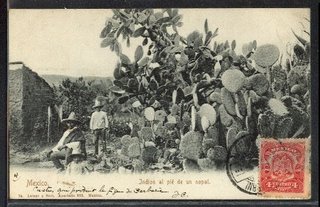
A handsome specimen from a web site. Hopefully not copyrighted, given the age of the card.
Ordered the following tomato seeds from totallytomatoes.com. This site was reliable last year so using it again. Varieties:
Lemon Boy - my favorite yellow. Here it's been very productive, juicy big tomatoes with a 'light' tomatoey flavor.
Celebrity - did not grow last year but want to try again. Disease resistant, productive, real 'midwestern' type tomato flavor.
Better Boy - grew OK last year, better in 2005. Good production, big 'midwestern' flavor tomatoes.
Black from Tula - new to me. Last year Cherokee was so good (but not productive), I want to try another black variety.
Cherokee Purple - "purple" but also called "black". not very productive, but so good that I had to hide tomatoes to save them for myself (don't tell Ning).
Supersweet 100 - Ning's favorite. After trying all of the varieties of cherry tomatoes, this one was still the most flavorful and productive. Most of the others either didnt make many, or they didn't have much flavor. Or both.
Tiny Tim - a very dwarf variety, never tried before. 15 inches tall. Will use in border areas or containers to produce some early cherry tomatoes or have them in spots that are too small for larger varieties.
I've been achy and tired. Probably combination of a virus, year-end iniatives / increased load at work, and some short day affective disorder. Looking ahead to the tomatoes helped a little.

Monday, December 25, 2006
Opuntia
These drawings from the USDA web site, original text is: Britton, N.L., and A. Brown. 1913. Illustrated flora of the northern states and Canada. I like these old drawings.
These are less likely to be damaged by cold and rain, compared to desert cacti. The two in the "GrowingGreener" yard are looking sad and have never bloomed, although they have survived the cold wet weather for several winters. I keep hoping for a 'prickly pear' to taste. Unknown varieties. If I can find a source, I would like to try an Opuntia fragilis (since it's native to WA) or an Opuntia microdasys, since it seems to remain small so I could bring it inside for the winter.
The images can be 'clicked' to render them more readable.
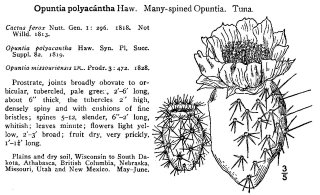
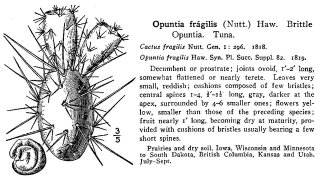
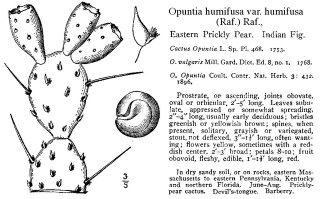

These are less likely to be damaged by cold and rain, compared to desert cacti. The two in the "GrowingGreener" yard are looking sad and have never bloomed, although they have survived the cold wet weather for several winters. I keep hoping for a 'prickly pear' to taste. Unknown varieties. If I can find a source, I would like to try an Opuntia fragilis (since it's native to WA) or an Opuntia microdasys, since it seems to remain small so I could bring it inside for the winter.
The images can be 'clicked' to render them more readable.




Sunday, November 12, 2006
Cactus therapy.

Some green therapy here. Each year I seem to find something different to over-do. One year it was roses, then tomatoes, then peppers, then figs. The roses are mostly still there, but out of favor due to high maintenance (except a few). I can only grow so many tomatoes or figs, and I think i have them more-or-less figured out for this area. The peppers are not so rewarding although I'll keep trying a few.
Without intending to, it looks like this time it's cacti. Looking around the yard and in the windows, there are quite a few. These are not well identified, but I'm thinking (left to right) Echinopsis sp, Gymnocalycium sp., and Selenocereus sp. These identifications may change if they have identifiable blossoms. Based on web photos, Gymnocalycium flowers are amazingly colorful.

I've been growing this cactus through about 4 'cutting generations' over a period of 15 years. It sits neglected in the yard in the summer, and occasionally I start a new pad. I've given away some of the larger plants due to moving, and one was killed in a frost. Now I want to try again. based on photos in a book and on the web, this is Opuntia neoargentina but could also go by Brasioliopuntia braziliensis and multiple other names. It has a yellow flower. It can grow as a tree on a thick trunk, and tiers of branches with pads that fall off when dry. The original was a gift from a friend in Lafayette indiana; his cactus was over 6 feet tall when I first saw it. Googling on this species, it appears to be threatened in its original habitat in much of its habitat, much of which has been destroyed in Brazil, but it also grows widely in some tropical areas.
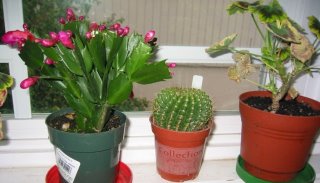
Today 2 more were added from Lowes. The result of an overly stressful week (if only I drank, I wouldnt have to keep adding vegetation around the house!). Given the winter season, a colorful Schlumbergera hybrid (labeled as Zygocactus) and a small Parodia (labeled as Notocactus herteri). The Notocactus comes in many colorful varieties.
Outside are 2 Opuntias that have survived two winters so far. Neither has blooded.
It's amazing to look at the photos of cactus flowers and read about their climates, and the history of their horticulture.

Subscribe to:
Comments (Atom)










